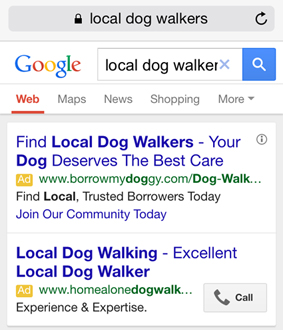Having a successful PPC strategy is crucial for businesses that pump the majority of budgets into Google AdWords. Competition for keywords is fierce, so advertisers can’t afford to settle for lower than average conversion rates. That’s why it’s important that PPC advertisers can accurately track PPC ad conversions to optimise their campaigns.
Most companies measure online conversions like web form submissions, but they’re not tracking valuable lead information from telephone calls. Despite everything going digital, studies have shown time and time again that consumers still wish to pick up the phone and talk to a real person.
Not tracking this information can severely misrepresent your conversion data. For example, how would you know whether someone called from your PPC ads or from an organic visit? This uncertainty can have a detrimental impact upon budgeting and optimisation decisions.
So, if you think that tracking and integrating your call data from your PPC campaigns isn’t important, here are six stats that will make you think again.
1. 6%-8% of mobile users are more likely to click on PPC ads that contain phone numbers
According to a mobile-local search stats report, people who are searching on their smartphones prefer to call a business rather than fill out a web form. It’s quicker and much easier on smaller devices. That’s why it’s imperative that your paid search ads use click-to-call ad extensions.
This functionality shortens the sales cycle because a clickable number enables potential customers to be connected directly with a business. And, in all honesty, if you’re in a hurry, which add would you rather click on?

2. 52% of people who click on PPC ads still go on to call the advertiser
The same mobile-local report also states that even if a mobile searcher clicks on a paid ad and goes to a mobile landing page, 52% of those website visitors will still go on to call a business.
So, even if your business doesn’t get a great deal of phone calls, you should be readily displaying a telephone number if you want to get those leads in quickly.
And not just any old number, a call tracking number that’s integrated with your PPC account is the only way you can track a caller who engaged with a PPC ad. Using the PPC call integration will provide you with masses of useful data which will help you to determine which of your ads are actually effective in the mobile PPC sales cycle, so you can adjust bids and ad spend accordingly.
3. PPC Phone leads are three times more likely to convert
According to a study of PPC lead conversions, PPC landing pages drove nearly twice as many phone leads as web downloads. This is incredibly important for businesses who secure more conversions through telephone interactions.
Tracking these consumer journeys using specific integrated PPC call tracking technology can surface valuable information about the sales path, from keywords used to landing pages visited. The use this information to optimise other areas of your marketing, not just PPC!
4. Inbound calls are worth 5 to 10 times the value of form fill leads
This study suggests that a phone call is worth between 500% to 1000% (5 to 10 times) more in revenue than a web form lead.
Considering how financially valuable telephone calls are compared to other enquiry methods, you would be doing your business a disservice if you weren’t correctly tracking these leads.
Traditional AdWords metrics track which campaign keywords, ads and landing pages trigger conversions to your site. But if a prospect picks up the phone, your ability to track these conversions is nigh on impossible without call tracking.
With PPC call tracking, you’ll add another element of analysis to your reports. Metrics such as call quantity, call length, time of day, location and landing page performance are other important quality metrics that you can feed back through to your PPC campaign performance. The point is, with a PPC call tracking integration; you can tie PPC calls back to your PPC costs. So if phone calls are the lifeblood of your business, you’ll now be able to optimise your campaigns for increased lead generation and ROI.
Here’s a snapshot from inside our call tracking report dashboard:
![]()
5. 78% of local searches on mobile result in offline purchases
It’s a well-known fact that if people are looking for a local business or service it’s a strong purchasing signal. What’s more, a recent Google study found that consumers take greater action on location based ads, saying it’s important for paid ads to show store address and phone numbers.
And with such a large number of local searches now resulting in offline purchases, it’s important that these searches find you.
When we use the term “offline purchases”, we mean that people have either bought an item in store or called a business. AdWords only tracks web form conversions; you cannot tell whether someone picked up the phone and called you, so there’s no way of tracing a local caller’s journey once they’ve picked up the phone.
If you have PPC call tracking in place, you’ll be able to tie calls back to keywords used, landing pages visited and which ad triggered the call. But more importantly, you’ll start to be able to build up a picture of how local searches contribute to revenue. Don’t forget to feed this data back into your paid search campaigns for improved local optimisation.
But what about leads who got away? Call tracking is able to show you both the consumer journey before and after a call. For example, you could gather location based interactions and call information from prospects that didn’t go onto make a purchase after a call ended. If you want to try to entice them back into the sales funnel, you could retarget them on your display network.
The bottom line is that your business wants calls. And your consumers want to be able to call you. If you’re not allowing potential customers to get in touch with you quickly, or your only calls to action are web forms, you’ll be turning potential business away.
Image credit: https://www.flickr.com/photos/robboudon/
Business Articles | Business 2 Community
(683)






